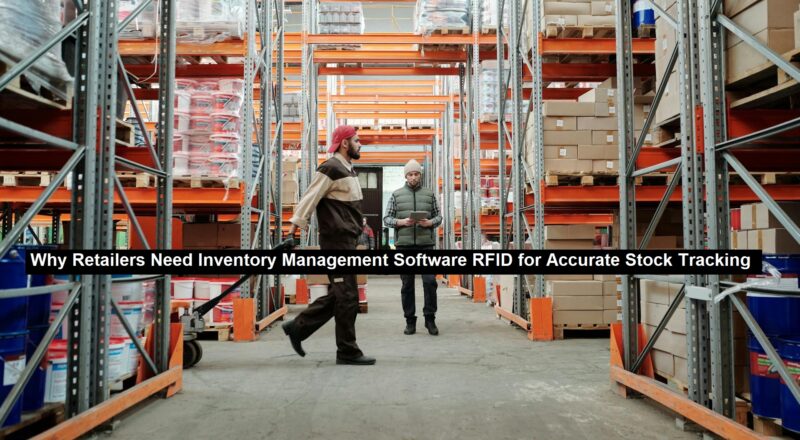The Future of Retail Stock Control
In the fast-paced world of retail, managing stock accurately can mean the difference between profit and loss. Retailers dealing with inventory challenges are turning to inventory management software RFID to gain better control over their stock levels. This technology is transforming how businesses track goods, reducing errors and improving efficiency.
Imagine running a clothing store where employees manually count each item. Not only is this time-consuming, but it’s also prone to human error. Now, picture the same store using RFID technology. Instead of scanning each product individually, RFID tags allow staff to check thousands of items in seconds.
How RFID Enhances Inventory Tracking
RFID (Radio Frequency Identification) is a game-changer for retailers. It replaces outdated barcode systems with wireless technology, allowing real-time tracking of stock. Unlike barcodes, RFID doesn’t require a direct line of sight, making scanning seamless and far more accurate.
Retailers who implement inventory management software RFID experience faster stock audits and reduced shrinkage. RFID systems can track product movements from the warehouse to store shelves, ensuring fewer discrepancies in inventory records. This means no more overstocking or running out of popular products unexpectedly.
inventory management software RFID provides complete visibility into stock movements, helping businesses maintain optimal inventory levels and enhance customer satisfaction.
Real-Life Benefits of RFID in Retail
A mid-sized fashion retailer struggled with stock discrepancies, often finding mismatched inventory between online orders and in-store availability. After adopting RFID-based tracking, they reduced stock-checking time by 90% and improved order fulfillment accuracy. Customers could now trust that products listed as “in stock” were actually available, leading to increased sales and fewer complaints.
For supermarkets, RFID prevents spoilage by tracking expiration dates efficiently. Instead of staff manually checking perishable goods, RFID sensors alert managers about items nearing expiry. This proactive approach minimizes waste and ensures fresh products for customers.
Reducing Labor Costs and Boosting Efficiency
Retailers spend significant time and resources on stock counts and loss prevention. Traditional inventory checks require extensive manpower, pulling employees away from customer service. RFID automates this process, allowing workers to focus on enhancing the shopping experience instead.
A department store in New York reported a 50% reduction in labor costs after switching to RFID. Employees who previously spent hours on inventory checks could now dedicate more time to assisting customers and restocking shelves. This not only improved productivity but also led to better customer satisfaction.
RFID and Omni-Channel Retailing
Modern retailers operate across multiple platforms—brick-and-mortar stores, online marketplaces, and mobile apps. Without accurate inventory tracking, businesses risk overselling online or understocking in physical stores. RFID bridges this gap by providing real-time inventory updates across all sales channels.
For example, a shoe retailer using RFID technology integrated their in-store and online inventory seamlessly. If a customer ordered a pair of sneakers online, the system automatically located the nearest store with available stock, ensuring fast delivery or easy pickup. This level of precision keeps customers happy and prevents lost sales.
Read: The Transformative Role of Agri-Tech in Modern Agriculture
Fighting Theft and Shrinkage with RFID
Retail shrinkage—whether due to theft, fraud, or administrative errors—costs businesses billions annually. RFID helps combat this issue by tracking each product from arrival to checkout. If an item leaves the store without being scanned at the register, security systems are instantly alerted.
A high-end electronics retailer saw a 30% drop in theft-related losses after deploying RFID-based tracking. By embedding RFID tags in high-value products, they could monitor movements and prevent unauthorized removals. This gave them greater control over stock security without intrusive security measures.
Making Smarter Purchasing Decisions
Retailers often struggle with knowing when and how much to reorder. Ordering too much ties up capital and storage space, while underordering results in lost sales. RFID-driven insights help businesses make data-driven purchasing decisions by identifying trends and demand patterns.
For instance, a sportswear brand used RFID analytics to discover which products sold fastest in different seasons. Armed with this data, they adjusted their purchasing strategy, ensuring high-demand products were always available at the right time. This not only increased sales but also minimized unsold inventory.
The Path to RFID Adoption
Adopting RFID technology might seem daunting, but the long-term benefits outweigh the initial investment. Retailers can start small by integrating RFID for high-value or frequently moving items before scaling up. Most modern inventory management software RFID solutions offer seamless integration with existing systems, making the transition smooth.
Training employees to use RFID efficiently is also straightforward. Since RFID readers scan multiple tags simultaneously, store associates can complete inventory checks in minutes rather than hours. This user-friendly system ensures quick adoption and immediate benefits.
Conclusion
RFID is revolutionizing the way retailers manage their stock, offering unparalleled accuracy and efficiency. From reducing shrinkage to improving customer satisfaction, inventory management software RFID provides a competitive edge in today’s retail landscape. Retailers who embrace this technology can streamline operations, cut costs, and enhance the overall shopping experience.
For businesses looking to future-proof their inventory management, RFID is no longer an option—it’s a necessity.
